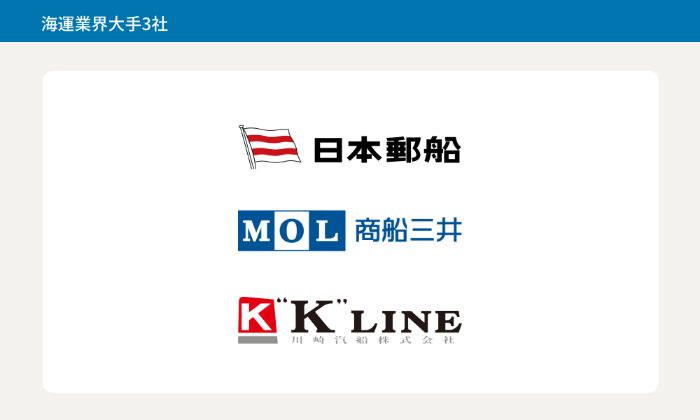
The three major shipping companies are having difficulty formulating their consolidated earnings forecasts for the fiscal year ending March 31, 2024.
In the October-December period of 2023, the yen is weaker than the companies’ expectations at around 144 yen to the dollar. In addition, global shipping companies have suspended sailing in the Red Sea and the Suez Canal, causing container shipping rates to soar. On the other hand, some shipping executives have pointed out that “shippers’ freight rates are not keeping pace” with the increased operating costs associated with the diversion. It remains to be seen whether the major shipping companies will be able to revise upward their year-end earnings for period of 2024, which will be announced in a series starting at the end of this month.(Text by Hirofumi Yamamoto)
The stock market has already priced in the upward earnings revisions of the shipping giants.
On January 16, 2024, the share prices of NYK, MOL and Kawasaki Kisen Kaisha reached new year-to-date highs on the Tokyo Stock Exchange’s Prime Market. Kawasaki Kisen’s price-to-earnings ratio rose to 1.10 times.
Most of the world’s shipping companies have announced that they will stop allocating ships to the Red Sea and Suez Canal, which is expected to tighten the supply-demand balance for container ships toward the end of the fiscal year,” said a securities analyst.
Recurring profit forecasts for the fiscal year ending March 2024 for each company are 235 billion yen for NYK, 220 billion yen for MOL and 135 billion yen for Kawasaki Kisen Kaisha, Ltd.
The ratio of dollar revenues to total revenues for ocean shipping is about 80%, the highest among the TSE prime markets. The sensitivity of each company’s recurring profit to exchange rate fluctuations shows that a ¥1 depreciation of the yen has the effect of increasing profit by ¥600 million to ¥1.4 billion (in the second half of FY2023).
The average exchange rate for the period from September to December 2023 was 143-144 yen to the dollar, 1-3 yen higher than the companies’ expectations. The yen has recently depreciated to around 147 yen per dollar.
The core shipping business is also performing well. The closure of the Suez Canal and the drought in the Panama Canal have led to an upward trend in ocean freight rates for container ships and tankers.
According to the Shanghai Shipping Exchange, as of December 22, 2023, spot freight rates from Shanghai to Europe per 20-foot container rose 62% in two weeks to the highest level in a year and a month.
The shipping giants will take a 38%, 31% and 31% stake, respectively, in Ocean Network Express (ONE), a container shipping company owned by NYK, MOL and Kawasaki Kisen Kaisha, Ltd.
A senior shipping executive believes that if ONE’s performance improves in the January-March 2024 period, it will boost the shipping giants’ recurring profit toward the end of the fiscal year.
The tanker market is also on the rise.
The drought in the Panama Canal has reduced the number of ships passing through the canal. Priority is being given to container ships and the number of slots (allotment) is lower than usual.
Freight rates for VLCCs (very large crude carriers) are currently above breakeven at $50,000 per day, while VLGCs (very large liquefied petroleum gas carriers) reached a record high of $170,000 per day in September last year. Although freight rates have slowed, they “remain firm,” according to a tanker manager at a major shipping line.
There are some concerns.
By not transiting the Suez Canal, shipping companies will increase the voyage time between Asia and Europe by about 10 days.
The longer voyage will result in higher costs for the operators (shipping companies), such as charter fees and bunker costs (fuel costs).
LNG (liquefied natural gas) carriers and car carriers cannot take the detour via the Cape of Good Hope (South Africa) at face value if it leads directly to higher freight rates and market conditions.
Qatar, a country in the Middle East, uses the Suez Canal as its main route for transporting LNG to Europe. Qatar, as a shipping country, regularly charters vessels from major shipping companies through EX-Ship, which itself has vessel allocation rights. Qatar would like to request that its vessels be deployed to the Red Sea, but the major shipping company is prioritizing the safety of its vessels and intends to temporarily suspend operations on this route.
A source involved in the LNG shipping industry said, “It remains difficult to explain to shippers the route selection process and the increased costs associated with diverting vessels.
Car carrier operations are also facing difficulties.
According to Clarksons, there are approximately 760 car carriers in existence. Although there are 170 vessels on order, “shipping capacity remains tight,” according to a senior shipping executive.
The shortage of shipping capacity to transport finished cars has accelerated since last year due to the increase in the number of EVs (electric vehicles) from China to Europe.
The shipping companies are worried that the diversion of ships will worsen the balance of payments: “On the contrary, it may lead to a decrease in the number of finished cars transported.
The question is whether the shipping giants will revise their forecasts for the fiscal year ending March 31, 2024 upward or leave them unchanged when they announce their financial results at the end of January 2024. In principle, the TSE requires timely disclosure of both upward and downward revisions, so this is likely to be a difficult decision.